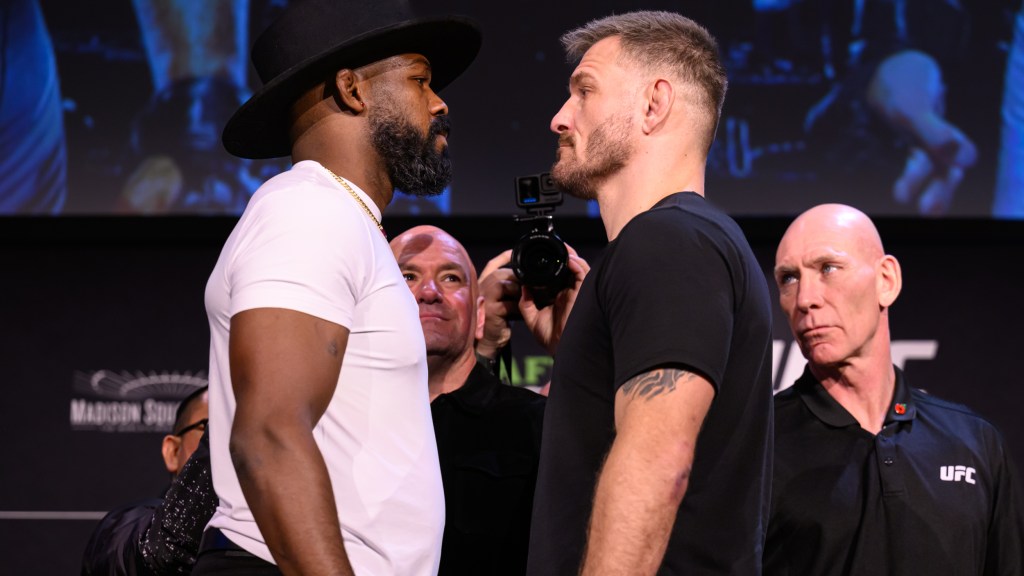An adjustment to Appendix Okay of the FIA’s Worldwide Sporting Code doesn’t, on the face of it, sound like a lot to get enthusiastic about. However for followers of historic racing, the choice introduced following final month’s World Motor Sport Council assembly to problem Historic Technical Passports (HTPs) to equipment constructed between 1991 and 2000 from subsequent 12 months may have main ramifications.
“It might be right for any person who owns a 1992 automotive to query, ‘Has my automotive fallen into the heritage or not? Is it a part of the historic motorsport?’” says FIA historic championships and committee supervisor Mathias Doutreleau.
Among the many tantalising prospects that will outcome from the primary vital change to Appendix Okay since 2014, the results of an FIA technical working group codenamed Undertaking 2025, is the prospect of a return for Components 3000 automobiles. Of their pomp earlier than going single-make for 1996, these offered efficiency to rival tail-end Components 1 equipment.
When reflecting on his first F1 check for Lotus at Silverstone in 1994, Max Papis attests that the “mesmerising” stage F3000 had reached made motor racing’s pinnacle barely much less spectacular than he had imagined. The Italian, who went on to race for Footwork in 1995, recollects: “After I drove out of the pit the primary time and I floored it, I used to be anticipating to have that very same feeling that I had after I drove the F3000 [for the first time], that it pushed me at the back of the seat and I used to be hanging on. It was not like that.”
Papis says the sensation of driving an F3000, the class that in 1985 changed European Components 2 because the principal coaching floor for F1 drivers, “was like sitting on a rocket”, and the reverence by which the automobiles are held immediately is broadly shared. For historic preparation specialist Nick Edgington, their self-evident enchantment is magnified by the mystique that surrounds them given “there’s been no dwelling for F3000 automobiles in any respect”.
“They’re simply implausible automobiles; they sound implausible and proportionally they give the impression of being proper, as you’d need a racing automotive to be,” enthuses Edgington, who has interval F3000 expertise as a mechanic on Yvan Muller’s Omegaland Reynard that gained the 1992 British F2 title. “Every time we’ve been out with an F3000 automotive at Donington on a common check day, folks simply don’t see them anymore, they usually simply don’t actually know what they’re”.
There may be presently nowhere for F3000 automobiles to race, though Sowter (in automotive) and Edgington hope that may quickly change
Edgington has since 2017 labored with Colin Sowter, who describes himself as “the chairman, the founder and the unique member of the membership of 1” with regards to F3000 zeal. To the proprietor of six F3000 automobiles, amongst them the title-winning ex-Roberto Moreno and Jean Alesi Reynards from 1988 and 1989 amongst his spectacular assortment, the Appendix Okay tweak affords hope that his automobiles will race once more.
“If there was someplace to race them, I might completely like to,” remarks Sowter, whose ex-Alesi 89D is because of be demonstrated by the Frenchman at subsequent 12 months’s Historic French Grand Prix. “It’s not for not desirous to race the automobiles, it’s been that there hasn’t been wherever to race them.”
Doutreleau says the governing physique plans to have a presence throughout Retromobile Paris subsequent February to help house owners of newly eligible historic automobiles in making use of for HTPs and reply any questions. However increasing the supply of HTPs is barely a part of the story for F3000. There has in concept been nothing stopping automobiles constructed between 1985 and 1990 from racing, in spite of everything.
Restricted availability and the excessive prices of sourcing engines is among the main hindrances to getting the automobiles working once more
The issue is actually twofold; along with there being nowhere for them to race, which Edgington attributes to closing dates and UK noise restrictions, steep prices will be offputting. As Sowter explains, “whereas the price of entry when it comes to your preliminary buy of F3000 is much less, the price of working and sustaining one is identical as a Components 1 automotive”. The funding concerned might simply dissuade potential F3000 house owners and push them in direction of proudly owning an F1 automotive as a substitute.
Though F3000 was devised as a method of discovering new houses for Cosworth DFV engines that had change into redundant in F1, with 9000rpm rev-limiters fitted as a cost-saving measure, restricted availability and the excessive prices of sourcing engines is among the main hindrances to getting the automobiles working once more.
As Edgington explains, whereas “there’s various rolling chassis round” – a number of went to Australia for Components Holden or have been used for hillclimbs – “it’s fairly uncommon to search out them with engines, particularly with the DFV.” The identical applies for automobiles that used Mugen or Judd propulsion, together with Sowter’s not too long ago acquired ex-Alessandro Zanardi Il Barone Rampante Reynard 91D that was powered in interval by Mugen.
“There’s not an entire load of these round, they’re fairly a uncommon beast as effectively,” Edgington provides. “To search out one after which get it rebuilt takes time. That tends to be the issue, and the most important price, getting engines sorted out.”

Discovering engine components after which funding the price of restoring them just isn’t simple
The engine itself isn’t the one downside, factors out Sowter. The injection and digital methods used to handle them need to be sourced too, since many DFVs have been transformed again to their authentic mechanical spec for historic F1 racing. All of it means “you’ve acquired to be very passionate about them to wish to spend the sum of money it takes”, shrugs Sowter.
If that each one seems like a whole lot of doom and gloom, Edgington doesn’t share it. These with the means who could be keen to place their cash on the desk is not going to be disenchanted, he believes. Your common gentleman historics racer “isn’t going to get any faster in a Components 1 automotive”, he says.
Operationally too, F3000 automobiles are much less onerous than F1 equipment since, for all their spectacular efficiency, they remained off-the-shelf racing automobiles. Though it wouldn’t be possible for an proprietor to take one to the monitor on a trailer and do every part themselves, Edgington permits that “you possibly can do it with a small workforce”.
That tallies with Mike Earle’s recollections of 1991, after returning to the class his Onyx workforce had gained with Stefano Modena in 1987 following its subsequent temporary stint within the grand prix paddock. “Getting back from F1 [with Ralts entered under the 3001 International banner], you realised how low-tech the F3000 automobiles have been, they have been nonetheless lots much less bold,” he says.
Historic bouts would possible be shorter than interval contests that usually exceeded an hour, since “your common novice driver would wrestle” with their physicality, Edgington notes. With shorter working occasions, engine mileage would stretch additional too.
Sowter hopes that the HTP will “elevate consciousness” of the probabilities of racing F3000 automobiles, with “a a lot greater pool of automobiles to tug on” in Europe, however is aware of that is simply step one. “It simply wants any person to chew the bullet and begin permitting them in,” he says. Edgington agrees: “It’s going to take a little bit of time.”
Each counsel {that a} possible workaround could be if an organiser agreed to run a mixed grid with historic F1, F5000 or certainly ground-effect F2 machines. “In the event that they get sufficient automobiles out on the again of the Components 1 race, they may then have a look at having a standalone grid,” causes Sowter.
Masters Historic Racing will embrace a demo occasion for ’90s F1 automobiles at Manufacturers Hatch on 31 Might-1 June, however plans to combine grids with F3000 automobiles aren’t on the playing cards, a spokesperson instructed Motorsport.com.

Doutreleau says the FIA will assist historic automotive house owners with making use of for HTPs via a workshop held in February
Photograph by: FIA
Doutreleau expresses optimism {that a} revival “will occur” in some type, although is at pains to emphasize “that is exterior of our scope, as a result of we’re not organisers”.
“Components 3000 undoubtedly has its spot,” he argues. “We hope that by placing collectively this regulation, it would spark the curiosity of a promoter or an organiser to say, ‘Effectively, nobody is celebrating Components 3000, I’ll be the primary one.’”
Apathy round promotion dogged F3000 in interval. It was remarked by Motorsport.com that racing at Albacete in 1992 was merely “one other manner of conserving F3000 out of the limelight”. It might actually be a pity if, with the fortieth anniversary of the class set to be celebrated subsequent 12 months, they remained hidden from view. Now the ready sport begins.
A short historical past of F3000 in Britain

Damon Hill, pictured in a Cobra Motorsport Reynard at Manufacturers Hatch in 1989, is among the many main alumni from the British F3000 championship
Photograph by: Motorsport Photos
Ought to a Components 3000 revival take root, it could be becoming if it did so in Britain, for the class all the time had an in depth hyperlink to those shores. Though F3000 racers have been constructed elsewhere too, Ralt, March, Lola and Reynard hoovered up all 206 races of the primary FIA championship between them, whereas tyres originating from Avon’s Melksham workshop have been on each winner from 1986 to F3000’s climax in 2004.
The very first F3000 race was held at Silverstone in 1985, with Mike Thackwell’s works Ralt taking victory within the Worldwide Trophy. Britain would host a spherical of the championship yearly till its 2004 demise, and in 1987 held 4 of the 11 races between Silverstone, Donington, Manufacturers Hatch and the Birmingham Superprix.
Such was the verve for F3000 {that a} spin-off nationwide sequence was launched by the BRSCC in 1989, however it endured combined fortunes over the following decade. From an preliminary motley assortment of 9 automobiles for the inaugural race at Manufacturers, gained by Andrew Gilbert-Scott in an Eddie Jordan Racing Reynard from Roland Ratzenberger’s Spirit-run machine, numbers steadily grew and had reached 20 automobiles by the top of 1990.
Rebranding as British F2 couldn’t disguise the truth that grids have been again in single figures and the depth had disappeared, with the prices of racing in a nationwide sequence deemed unattractive
A name to ban present equipment on the finish of that season, claimed by Pedro Chaves in a Mansell Madgwick Reynard 90D, was arguably the proper one and established the British sequence as a house for year-old equipment that attracted promising worldwide expertise. Future British Touring Automotive champions Alain Menu and Rickard Rydell have been each race winners in 1990, whereas Swedish tin-top ace-to-be Fredrik Ekblom strung collectively a hat-trick within the closing phases of 1991.
Phil Andrews raced within the championship on and off between 1990 and 1994, and stresses “there was a whole lot of high quality in depth” in 1991. That 12 months Paul Warwick was topped posthumously after the likes of Andrews, Richard Dean, Dave Coyne and Julian Westwood took factors away from Ekblom. One other perk was “first rate prize cash, which was changing into uncommon by then”, says Andrews, who returned to the FIA sequence for 1992, when Yvan Muller gained the British title.
However Andrews is the primary to confess that by 1993, it felt like a really completely different championship. Rebranding as British F2 couldn’t disguise the truth that grids have been again in single figures and the depth had disappeared, with the prices of racing in a nationwide sequence deemed unattractive. It staggered alongside via 1994, when unreliability price Andrews the title, earlier than prudently taking a one-year hiatus.
One final hurrah in 1996 attracted Worldwide F3000 dominator Tremendous Nova and gave hope. However a closing race with three automobiles in 1997, gained by Dino Morelli, was the embarrassing final straw.

Birmingham was certainly one of 4 British rounds on the Worldwide F3000 calendar in 1987
Photograph by: Sutton Photos






